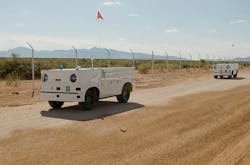Honda conducts field test of Autonomous Work Vehicle at Black & Veatch’s solar construction site
Honda has conducted a month-long field test of its fully-electric Autonomous Work Vehicle (AWV) prototype at Black & Veatch’s large-scale solar energy construction site in New Mexico.
The AWV performed functions, including the transport of supplies, like building materials and water, to pre-set destinations at the work site. The test was successful.
Support structures for the solar panels at the site have been laid out in a grid pattern at regular intervals. It was an ideal environment to test the AWV’s ability to stop at certain points along the route. The Black & Veatch operators had been provided a high-definition map of the site so they could set the start and destination points for the AWV on a cloud-based app.
During the test, the viability of the AWV’s battery was also successfully tested, proving the system capable enough to support the built-in energy-intensive sensors and provide vehicle propulsion, while operating in a high-temperature environment for eight hours. The AWV carried 900 pounds of payloads and towed a trailer, which carried 1,600 pounds.
The Honda AWV was equipped with sensors, GPS, radar, lidar and stereoscopic (3D) cameras for autonomous operation, navigation, obstacle detection and remote monitoring.
About the Author
EnergyTech Staff
Rod Walton is senior editor for EnergyTech.com. He has spent 17 years covering the energy industry as a newspaper and trade journalist.
Walton formerly was energy writer and business editor at the Tulsa World. Later, he spent six years covering the electricity power sector for Pennwell and Clarion Events. He joined Endeavor and EnergyTech in November 2021.
He can be reached at [email protected].
EnergyTech is focused on the mission critical and large-scale energy users and their sustainability and resiliency goals. These include the commercial and industrial sectors, as well as the military, universities, data centers and microgrids.
Many large-scale energy users such as Fortune 500 companies, and mission-critical users such as military bases, universities, healthcare facilities, public safety and data centers, shifting their energy priorities to reach net-zero carbon goals within the coming decades. These include plans for renewable energy power purchase agreements, but also on-site resiliency projects such as microgrids, combined heat and power, rooftop solar, energy storage, digitalization and building efficiency upgrades.
